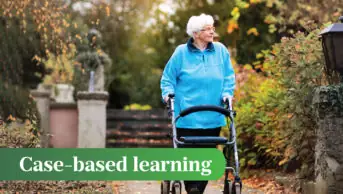
Shutterstock.com
Swallowing difficulties, known as ‘dysphagia’, are common among older people, particularly those diagnosed with a progressive neurological disease or dementia. Where I work, in Bridgend, Wales, there are 8 registered care homes with a total of 867 residents. Of these, between 50–75% are at risk of having dysphagia.
On average, the number of referrals from care homes for issues related to swallowing have been increasing annually. However, owing to limited service resource, many patients face a long wait before they are seen. Under the current model of care, patients are first referred to speech and language therapy for assessment before being referred to other professions — such as dietetics for nutrition reviews and GPs for medication reviews — resulting in further waiting times.
It is widely known that professions working ‘in silo’ is not the best way to provide optimal patient care. We often see patients switched to liquid medication when experiencing swallowing difficulties; however, if this is done without consulting relevant colleagues, it may put the patient at risk of aspiration if they can no longer swallow non-thickened fluids safely. By consulting with speech and language colleagues, following a formal assessment, there may be a safer and more cost-effective solution available.
A new approach was first suggested by Sheiladen Aquino, one of our speech and language therapists in Bridgend. It was clear that our current way of working was not resulting in the best care for our patients and we felt that an integrated approach to assessing and treat dysphagia was the best option to resolve the lack of co-ordination between services.
This collaboration ensures the patient is able to get the safest and most appropriate medicine in the shortest time frame
As a result, in June 2022, we set up a pilot to explore the use of a remote, multidisciplinary assessment for people experiencing dysphagia in care homes. In the pilot, the assessment and recommendations for each patient were made jointly between a speech and language therapist, dietitian, and pharmacist to ensure patients had the most appropriate dietary intake and medication formulation based on their swallowing ability.
Our project team comprised of Lucy Marland, our dietitian; Amber McCollum, a speech and language therapist; myself, the pharmacist; and Sheiladen Aquino, the project lead. In conjunction with the care home teams, we co-produced our service pathway, a single multidisciplinary team (MDT) referral form and training materials. We then recruited three nursing homes in the Bridgend locality to participate in our pilot.
During each consultation, the patient is assessed by the speech and language therapist before fluid and dietary recommendations are made. As the pharmacist in the team, I liaise with the speech and language therapist to review the patient’s medication and find the most appropriate formulation for any medication they are unable to swallow. This collaboration ensures the patient is able to get the safest and most appropriate medicine in the shortest time frame. This all leads to a holistic review of their needs during a single assessment.
During the pilot, we supported 47 people to remain healthy, preventing 66 hospital bed days with an attributable cost of more than £40,000, and increased capacity within the service to see an extra 50 people per year.
I have learnt a lot from my colleagues during this project and we all feel more comfortable with asking questions pertaining to other professions. This means we can work together to formulate a safe and effective patient-centred plan and avoids patients having to repeat their story in several different consultations.
We have adopted a value-based healthcare approach to improving patient outcomes. Value-based healthcare is a person-centred approach that aims to understand what matters most to the patients. This allows us to use our resources efficiently to provide high-value care that has the best outcomes for our patients. This has been achieved by utilising existing web-based teleconferencing software and restructuring the way in which healthcare professionals work.
By using the ‘Attend Anywhere’ video consultation platform, which was rolled out in Wales in response to the COVID-19 pandemic, we are able to assess patients promptly, reducing the average wait time for a consultation from 127 days, before the project, to just 23 days. Patients are receiving more prompt care and an enhanced experience through patient-centred MDT working.
It is evident from interviewing care home staff that they have benefited greatly from the project
We were also able to show several secondary outcomes by interviewing the project team involved, such as improved efficiencies, patient safety and — most prominently — the benefits to professions, care homes and patients.
It is evident from interviewing care home staff that they have benefited greatly from the project. We have worked with compassionate and inspiring care home staff that clearly want what is best for their patients. By offering additional training and a service that enables them to see patients at risk of aspiration, in a more timely manner, care home staff reported that they felt better supported to care for their, often complex, patients.
In November 2022, our pilot won the Welsh ‘Advancing Healthcare Award’ for ‘New Ways of Working’, which gave us the opportunity to spread the word about our multidisciplinary way of working. This spotlight has also enabled us to recruit new nursing homes that are eager to join this new way of working to support their patients. And, for me, it has highlighted the value that our profession can offer patient care and interdisciplinary working.
Our aim is that, by August 2023, we will be able to support the 1,920 residential care home residents in Bridgend and, by 2025, we will see similar services offered to care home residents across Wales.
Thomas Sauter is the clinical lead pharmacist for integrated community services for Cwm Taf Morgannwg University Health Board in Wales
1 comment
You must be logged in to post a comment.



Fantastic piece of work.